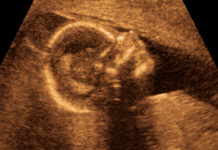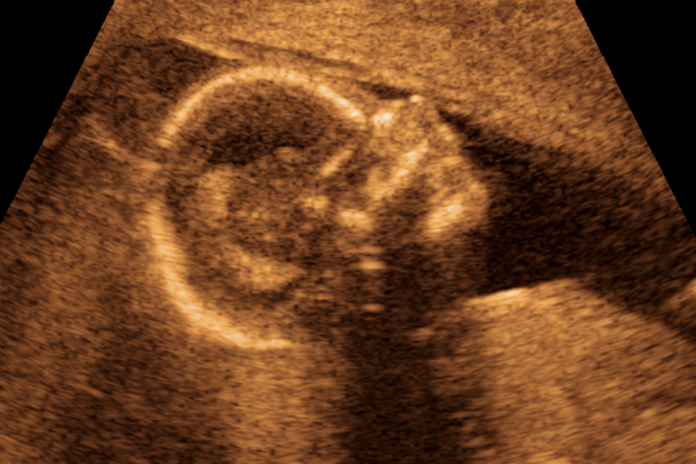#1. In 2014, 49 reporting areas released data showing that over 652,000 legal induced abortions occurred in the United States. That meant the abortion rate for the year was 12.1 for every 1,000 women between the ages of 15-44, which is the lowest recorded ratio recorded since abortion was effectively legalized in 1973. (CDC)
#2. The total number of abortions reported in 2014 was 2% lower than it was the year before. The ratio of legal induced abortions decreased by 7%. From 2005 to 2014, the rate, number, and ratio of reported legal induced abortions all fell by more than 20%. (CDC)
#3. 91.5% of the abortions that were reported in 2014 within the United States took place before 13 weeks’ gestation. Another 7.2% of the reported legal induced abortions occurred between 14 to 20 weeks’ gestation. (CDC)
#4. Only 1.3% of the legal induced abortions reported in the United States occurred after 21 weeks’ gestation. (CDC)
#5. About 1 in 4 of all abortions were reported as early medical abortions in 2014. The percentage of these abortions have increased by 110% from 2005 to 2014, but they increased by just 1% from 2013-2014. (CDC)
#6. Since 1900, the total number of abortions reported in the United States has decreased by more than 50%. In 1990, 1.4 million abortions were reported, compared to the 652,000 that were reported in 2014. (CNN)
#7. Since 1973, there have been more than 60 million total abortions, if the projections of 920,000 abortions from 2015 to 2017 are included in the overall figure. (Guttmacher Institute)
#8. Part of the reason why abortion numbers have gone down is that there are fewer facilities performing this procedure. Between 2008-2011, a total of 65 facilities performing 1,000 or more legal induced abortions were closed in the United States. (National Right to Life Educational Foundation)
#9. Some agencies also count chemical abortions as part of their reporting figures. For example, since 1965, about 11 million women in the U.S. have used abortifacient methods of birth control. This form of birth control may have prevented up to 14 million pregnancies per year, which would create a total of 610 million chemical abortions since 1965. (American Life League)
#10. With 2.7 million clients, Planned Parenthood provided 10.6 million women’s health services in 2013. Just 3% of the services provided by the organization involved abortion. 42% of their services involved testing and treatment for sexually transmitted diseases or infections, while another 34% involved contraception. (The Washington Post)
#11. Of the total number of reported legal induced abortions which occur in the United States, Planned Parenthood provides about 50% of the procedures. In 2013, the organization reported a total of more than 327,000 abortion services provided to women. (The Washington Post)
#12. The Susan B. Anthony List reports that 94% of the services provided by Planned Parenthood are related to abortion services. They do so by comparting abortions to the number of prenatal services and adoption referrals that the organization provided. The issue here is that the total number of pregnant women served has not been reported by the organization since 2009. (The Washington Post)
#13. In 2014, 19% of pregnancies that occurred in the United States, excluding miscarriages, were ended by abortion services. (Guttmacher Institute)
#14. At the rates of abortion that were reported in 2014, about 5% of women in the United States will have had at least one abortion by the age of 20. By the age of 30, 19% of women will have had at least one abortion. By the age of 45, the percentage climbs to 24%. (Guttmacher Institute)
#15. Over 50% of the abortions which occur in the United States each year involve women who are in their 20s. About 1 in 3 legal induced abortions are for patients between the ages of 20 to 24. When the 25-29 age demographic is combined with the 20-24 age demographic, these patients account for 61% of the total number of legal induced abortions. (Guttmacher Institute)
#16. In 2014, 12% of abortion patients were classified as a “minor” or “adolescent.” 3% of the legal induced abortions were performed for patients between the ages of 15 to 17. (Guttmacher Institute)
#17. 0.2% of the annual reported abortions are for girls who are younger than 15. (Guttmacher Institute)
#18. From a racial perspective, Caucasian/Whites are under-represented in the abortion statistics, while Blacks/African-Americans and Hispanics are over-represented. Whites/Caucasians represent 39% of the total legal induced abortion procedures, but account for 60% of the population in the 2010 census. Blacks/African-Americans account for 13% of the U.S. population, but 28% of U.S. legal induced abortions. Hispanics account for 18% of the U.S. population, but 25% of the abortion statistics. (Guttmacher Institute / U.S. Census Bureau)
#19. 17% of abortion patients in 2014 had it noted in their patient chart that their religious preference was mainline Protestant. 13% identified themselves as Evangelical. 38% of women who sought abortion services reported that they had no religious affiliation. (Guttmacher Institute)
#20. 1 in 4 women who seeks out abortion services in the United States identifies themselves as being Catholic. (Guttmacher Institute)
#21. 46% of the patients who spoke with their doctor or provider about abortion services and never married and were not living with someone else when they became pregnant. (Guttmacher Institute)
#22. 14% of women who made an appointment for abortion services were married in the last month when they became pregnant. (Guttmacher Institute)
#23. 59% of the legal induced abortions that were performed in the United States in 2014 were sought by women who’d had at least one previous successful live birth. (Guttmacher Institute)
#24. 3 out of 4 women who seek out abortion services had a household income which qualified them as being low-income or poor. 49% of women had an HHI that was less than 100% of the federal poverty level in the U.S., which was $15,730 in 2014. (Guttmacher Institute)
#25. 26% of women who seek abortion services live in a household with an HHI between 100% to 199% of the federal poverty level. (Guttmacher Institute)
#26. 51% of abortion patients in the United States reported that they were using some form of contraceptive. 24% said that they were using condoms, while 13% of women said they were using a hormonal form of birth control. (Guttmacher Institute)
#27. Between 1990 and 2016, the annual ratio of abortions to live births dropped by 34% in Israel, with the number of abortions for every 1,000 women of child-bearing age dropping from 13.6 to 9. (Haaretz)
#28. Despite women in Israel qualifying for government-approved and paid-for legal induced abortions, the number of requests to pregnancy-termination committees at hospitals in Israel has dropped by 42% since 1990. (Haaretz)
#29. In 1990, there were 103,000 babies born in Israel. In 2016, there were 188,000 babies born. The number of abortions, however, has stayed constant at 20,000 per year. (Haaretz)
#30. An estimated 56 million abortions occur around the world each year. About 25 million of those abortions are classified as an unsafe procedure. (World Health Organization)
#31. 97% of the abortions which are classified as “unsafe” occur in the developing countries of Latin America, Asia, and Africa. (World Health Organization)
#32. From 2010 to 2014, the 55% of abortions conducted safely meant that a trained health worker using globally-recommended methods appropriate for the pregnancy term were used. 31% of abortions are classified as “less safe,” which meant that out-of-date methods or untrained people using a safe method were used to complete the procedure. (World Health Organization)
#33. In countries where abortion is still banned, or only permitted when it is necessary to save the life of the mother or preserve her health, only 25% of abortions meet the “safe” definition. In countries were access restrictions to abortion are removed, 90% of the procedures meet the “safe” definition. (World Health Organization)
#34. Government laws which restrict a woman’s access to legal induced abortion services does not reduce the total number of abortions that occur. It only reduces the number of “safe” services which are offered. In Malta and Ireland, where abortion services have traditionally been restricted or outlawed, the rates of abortion match those in countries of similar development with fewer restrictions. (The Guardian)
#35. The number of facilities providing abortion services in the United States fell from 1,720 in 2011 to 1,671 in 2014, a decline of 3%. The number of clinics providing abortion services also declined, falling from 839 to 788, a decline of 6%. (Guttmacher Institute)
#36. 90% of counties in the United States in 2014 did not have a single clinic which provided abortion services. About 40% of women of child-bearing age lived in these counties. (Guttmacher Institute)
#37. About half (46%) of the clinics providing abortion services offered very early abortions, defined as occurring at 4 weeks’ gestation or sooner. 99% of clinics offered services for 8 weeks’ gestation or sooner. (Guttmacher Institute)
#38. The average cost of an abortion in the United States, in a non-hospital setting, at 10 weeks’ gestation, was $508 if local anesthesia was used. For an early medication abortion, up to 9 weeks’ gestation, the average cost was $535. (Guttmacher Institute)
#39. 84% of clinics which perform abortion services for their patients reported that they saw at least one form of anti-abortion protesting in 2011. 80% said that picketing was done outside their facility at least once. 47% of clinics reported harassing phone calls. (Guttmacher Institute)
#40. 53% of clinics in the U.S. which perform abortion services reported that they had been picketed at least 20 times during the year. (Guttmacher Institute)
#41. 3% of clinics reported that they had received at least one bomb threat over the past 12 months in 2011. (Guttmacher Institute)
#42. From 2010 to 2014, the global annual rate of abortion for all women of child-bearing age was 35 per 1,000, which is down from 40 per 1,000 figures that were released from 1990 to 1994. (Guttmacher Institute)
#43. The rate of abortion in the United States for all women of reproductive age is about one-third of what the global rate happens to be. (35 per 1,000 vs. 12.4 per 1,000). (Guttmacher Institute)
#44. The highest rates of abortion occur in the Caribbean, where 59 per 1,000 women of reproductive age seek abortion services. In South America, the rate is 48 per 1,000 women. Western Europe has the lowest rates at 16 per 1,000 women, followed by North America at 17 per 1,000 women. (Guttmacher Institute)
#45. The abortion rate in Africa has remained steady since 1990, where 34 per 1,000 women of child-bearing age seek out services. (Guttmacher Institute)
#46. About 6% of women live in a country where abortion is banned outright. Another 37% of women live in a country where it is allowed without restriction. In-between these two extremes are countries with laws that require some type of restriction. (Guttmacher Institute)
#47. In 2014, the estimated cost to provide post-abortion care in the developing world, where abortion rates are the highest, was $232 million. (Guttmacher Institute)
#48. About 8% of the maternal deaths which are reported worldwide are due to unsafe abortion procedures being offered. About 23,000 women each year die because of complications which occur after receiving an unsafe abortion. (Guttmacher Institute)
#49. In 2006, 49% of pregnancies were unintended in the United States. By 2011, 45% of pregnancies were unintended. For women who were 19 years of age or younger, 80% of pregnancies were unintended. (CDC)
#50. An estimated 214 million women in developing countries have an unmet need for contraception access. That means they are attempting to avoid a pregnancy, but they are using tradition methods of contraception or using no method at all. (Guttmacher Institute)
#51. 84% of unintended pregnancies in developing countries occur among women who have unmet needs when it comes to modern contraception. (Guttmacher Institute)
#52. About 100 million unintended pregnancies occur every year around the world. 56% of these unintended pregnancies will end with an abortion. (Guttmacher Institute)
#53. 31% of non-hospital abortions which occur in the United States involve medication. 45% of these abortions occur before 9 weeks’ gestation. (Guttmacher Institute)
#54. 87% of the non-hospital abortion providers in the United States provided at least one medication abortion. About 1 in 4 non-hospital clinics stated that they only provided early medication abortion. (Guttmacher Institute)
#55. Major complications, defined as the need for surgery, transfusion, or hospital care, occur at a rate of 0.5% or lower in the United States when the procedure is performed during the first trimester. (Guttmacher Institute)
#56. The risk of death because of an abortion procedure in the U.S. is directly linked to the time of gestation. Before 8 weeks’ gestation, the risk of death is 0.3 for every 100,000 procedures performed. At 18 weeks or later, the risk of death climbs to 6.7 per 100,000 procedures. (Guttmacher Institute)
#57. 53% of women who had an abortion in 2014 paid for their procedure out-of-pocket, even though 35% had Medicaid coverage and 31% had private insurance of some type. (Guttmacher Institute)
#58. 61% of patients who held some type of private insurance decided to pay for their abortion services out-of-pocket. (Guttmacher Institute)
#59. At the start of 2018, 40 states within the U.S. had imposed at least one of the following 5 restrictions on abortion procedures: unnecessary regulations, mandated counseling, mandated waiting periods, parental involvement requirements, and prohibition of using Medicaid funds for an abortion deemed to be medically necessary. (Guttmacher Institute)
#60. Although 17 states have a policy which requires the state to provide Medicaid coverage for abortion services, only 15 are actually implementing such a practice. (Guttmacher Institute)
#61. 76% of patients who sought abortion services were able to obtain their procedure with 7 days of calling to schedule their initial appointment. 7% of women had to wait 14+ days to have their procedure. (Guttmacher Institute)
#62. In 2000, there were 13 states in the U.S. which had a minimum of 4 types of major abortion restrictions. In 2018, there were 29 states which met this minimum standard. 58% of women who are of child-bearing age live in a state with at least 4 major restrictions in place. (Guttmacher Institute)
#63. At the same time, the number of states which were labeled as “supportive” of abortion rights fell from 17 to 12 between 2000-2017. Only 30% of women in the U.S. live in states that are deemed to be supportive. (Guttmacher Institute)
#64. In the 14 developing countries where unsafe abortion rates are the highest, 40% of women who seek out abortion services will develop a complication that is serious enough to warrant medical attention. (The Guardian)
#65. 130 women die every day around the world because they sought out abortion services that the World Health Organization classifies as being unsafe. (The Guardian)
#66. South African began allowing legal induced abortions in 1997. Since then, the number of women who have died because of complications associated with an unsafe termination dropped by 90% in just 3 years within the country’s public facilities. (The Guardian)
#67. All pregnancy loss is referred to as an “abortion” of some type. The term “miscarriage” is used to describe what is medically known as a “spontaneous abortion.” About 80% of these abortions occur within the first 12 weeks of the pregnancy. (Johns Hopkins)
#68. About 50% of the spontaneous abortions which occur involve some type of chromosomal abnormality or anomaly. (Johns Hopkins)
#69. Among women who know they are pregnant, the rate of spontaneous abortion is between 10% to 20%. For all women who are pregnant, the rate can be as high as 50% globally. That makes it the most common complication of an early pregnancy. (National Institutes of Health)
#70. About 5% of women who experience a spontaneous abortion will experience two of them in a row. (Postgraduate Medical Journal)
#71. For women under the age of 35, the risk of a spontaneous abortion is around 10%. For women who are above the age of 40, the risk is about 45%. (Johns Hopkins)
Society may never fully agree on what it means to end human life potentiality. Whether one is for abortion or against it, there is no denying the fact that a legal induced abortion prevents human life potentiality. What that means is up to each individual, each woman facing an unexpected pregnancy, and each family that must decide what they are going to do.
What we must remember is that even though women give birth and abortion is part of the reproductive rights spectrum, it is not the woman’s sole fault that she becomes pregnant. Unexpected pregnancies require two parties to be involved.
The definition of being “pro-life” means that one is for every life. That means we must support one another, rich or poor, young or old, to make our society better.














